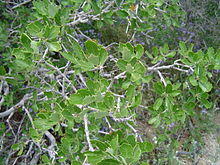| Quercus berberidifolia | |
|---|---|
 | |
| Scientific classification | |
| Kingdom: | Plantae |
| Clade: | Tracheophytes |
| Clade: | Angiosperms |
| Clade: | Eudicots |
| Clade: | Rosids |
| Order: | Fagales |
| Family: | Fagaceae |
| Genus: | Quercus |
| Subgenus: | Quercus subg. Quercus |
| Section: | Quercus sect. Quercus |
| Species: | Q. berberidifolia |
| Binomial name | |
| Quercus berberidifolia | |
| Synonyms[2] | |
| |
Quercus berberidifolia, the California scrub oak, is a small evergreen or semi-evergreen shrubby oak in the white oak section of Quercus. It is a native of the scrubby hills of California, and is a common member of chaparral ecosystems.[3]
Description
Quercus berberidifolia grows to 1–2 meters (40-80 inches) tall, rarely to 4 meters (160 inches) or 13 feet), and has sharply toothed, dull green leaves which are 1.5–3 cm (0.59–1.18 in) long and 1–2 cm (0.5–1 in) broad, leathery on their top surfaces and somewhat hairy underneath. The solitary or paired brown acorns are 1–3 cm (0.5–1 in) long and 1–2 cm (0.5–1 in) broad, and pointed or egg-shaped with thin caps when mature; they mature in about 6–8 months after pollination. In cooler, more exposed areas, scrub oak is usually a small, compact shrub, but in warm or sheltered areas the plant can spread out and grow several meters high.[4]
The epithet berberidifolia means "barberry-leaved," referring to the spiny leaf margins characteristic of Q. berberidifolia as well as of several species of Berberis.
Other species
Often known simply as scrub oak, though this name is also applied to other Quercus species, especially several which were formerly grouped under the single name Q. dumosa, all are found in scrubby habitats. Many other scrub-type oaks may be found in these regions, and careful inspection is required to identify individuals of Q. berberidifolia and its hybrids.
Quercus berberidifolia sometimes hybridizes with other species.
Chaparral origins
The word chaparral is derived from the Spanish word for scrub oak, chaparro. The non-specific meaning of the term is 'short in stature.' Because most scrub vegetation is rather low growing, the term is broadly applied to all of the vegetation in "chaparral" communities.
References
- ^ "Quercus berberidifolia". IUCN Red List of Threatened Species. 2015. 2015. Retrieved 5 November 2017.
data
- ^ "Quercus berberidifolia Liebm.". World Checklist of Selected Plant Families (WCSP). Royal Botanic Gardens, Kew – via The Plant List.
- ^ "Quercus berberidifolia". Calflora: Information on California plants for education, research and conservation, with data contributed by public and private institutions and individuals, including the Consortium of California Herbaria. Berkeley, California: The Calflora Database – via www.calflora.org.
- ^ Nixon, Kevin C. (1997). "Quercus berberidifolia". In Flora of North America Editorial Committee (ed.). Flora of North America North of Mexico (FNA). 3. New York and Oxford – via eFloras.org, Missouri Botanical Garden, St. Louis, MO & Harvard University Herbaria, Cambridge, MA.
